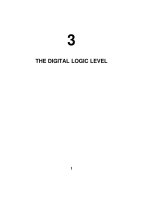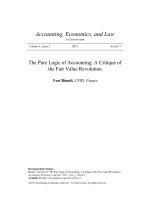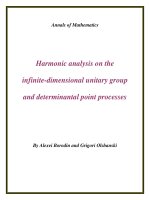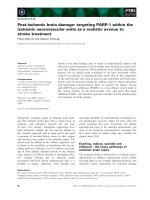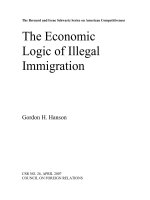P3 the arithmetic logic unit
Bạn đang xem bản rút gọn của tài liệu. Xem và tải ngay bản đầy đủ của tài liệu tại đây (4.51 MB, 91 trang )
Part III
The Arithmetic/Logic Unit
Jan. 2007
Computer Architecture, The Arithmetic/Logic Unit
Slide 1
About This Presentation
This presentation is intended to support the use of the textbook
Computer Architecture: From Microprocessors to Supercomputers,
Oxford University Press, 2005, ISBN 0-19-515455-X. It is updated
regularly by the author as part of his teaching of the upperdivision course ECE 154, Introduction to Computer Architecture,
at the University of California, Santa Barbara. Instructors can use
these slides freely in classroom teaching and for other
educational purposes. Any other use is strictly prohibited. ©
Behrooz Parhami
Edition
Released
Revised
Revised
Revised
Revised
First
July 2003
July 2004
July 2005
Mar. 2006
Jan. 2007
Jan. 2007
Computer Architecture, The Arithmetic/Logic Unit
Slide 2
III The Arithmetic/Logic Unit
Overview of computer arithmetic and ALU design:
• Review representation methods for signed integers
• Discuss algorithms & hardware for arithmetic ops
• Consider floating-point representation & arithmetic
Topics in This Part
Chapter 9
Number Representation
Chapter 10 Adders and Simple ALUs
Chapter 11 Multipliers and Dividers
Chapter 12 Floating-Point Arithmetic
Jan. 2007
Computer Architecture, The Arithmetic/Logic Unit
Slide 3
Computer Arithmetic as a Topic of Study
Brief overview article –
Encyclopedia of Info Systems,
Academic Press, 2002,
Vol. 3, pp. 317-333
Our textbook’s treatment
of the topic falls between
the two extremes (4 chap.)
Graduate course
ECE 252B – Text:
Computer Arithmetic,
Oxford U Press, 2000
Jan. 2007
Computer Architecture, The Arithmetic/Logic Unit
Slide 4
9 Number Representation
Arguably the most important topic in computer arithmetic:
• Affects system compatibility and ease of arithmetic
• Two’s complement, flp, and unconventional methods
Topics in This Chapter
9.1 Positional Number Systems
9.2 Digit Sets and Encodings
9.3 Number-Radix Conversion
9.4 Signed Integers
9.5 Fixed-Point Numbers
9.6 Floating-Point Numbers
Jan. 2007
Computer Architecture, The Arithmetic/Logic Unit
Slide 5
9.1 Positional Number Systems
Representations of natural numbers {0, 1, 2, 3, …}
||||| ||||| ||||| ||||| ||||| ||
27
11011
XXVII
sticks or unary code
radix-10 or decimal code
radix-2 or binary code
Roman numerals
Fixed-radix positional representation with k digits
k–1
Value of a number: x = (xk–1xk–2 . . . x1x0)r = xi r i
i=0
For example:
27 = (11011)two = (124) + (123) + (022) + (121) +
(120)
Number of digits for [0, P]: k = logr (P + 1) = logr P + 1
Jan. 2007
Computer Architecture, The Arithmetic/Logic Unit
Slide 6
Unsigned Binary Integers
0000
1111
1110
15
0
0001
1
14
0010
2
1101
0011
13
1100
12
1011
Turn x notches
counterclockwise
to add x
3
Inside: Natural number
Outside: 4-bit encoding
11
4
5
10
1010
0100
0101
12
11
10
15
1
0
2
3
4
9 8 7
6
5
6
9
1001
14
13
8
1000
7
0110
0111
Turn y notches
clockwise
to subtract y
Figure 9.1 Schematic representation of 4-bit code for
integers in [0, 15].
Jan. 2007
Computer Architecture, The Arithmetic/Logic Unit
Slide 7
Representation Range and Overflow
Overflow region max
max
Numbers smaller
than max
Overflow region
Numbers larger
than max
Finite set of representable numbers
Figure 9.2 Overflow regions in finite number representation systems.
For unsigned representations covered in this section, max – = 0.
Example 9.2, Part d
Discuss if overflow will occur when computing 317 – 316 in a number
system with k = 8 digits in radix r = 10.
Solution
The result 86 093 442 is representable in the number system which
has a range [0, 99 999 999]; however, if 317 is computed en route to
the final result, overflow will occur.
Jan. 2007
Computer Architecture, The Arithmetic/Logic Unit
Slide 8
9.2 Digit Sets and Encodings
Conventional and unconventional digit sets
Decimal digits in [0, 9]; 4-bit BCD, 8-bit ASCII
Hexadecimal, or hex for short: digits 0-9 & a-f
Conventional ternary digit set in [0, 2]
Conventional digit set for radix r is [0, r – 1]
Symmetric ternary digit set in [–1, 1]
Conventional binary digit set in [0, 1]
Redundant digit set [0, 2], encoded in 2 bits
( 0 2 1 1 0 )two and ( 1 0 1 0 2 )two represent 22
Jan. 2007
Computer Architecture, The Arithmetic/Logic Unit
Slide 9
Carry-Save Numbers
Radix-2 numbers using the digits 0, 1, and 2
Example: (1 0 2 1)two = (123) + (022) + (221) + (120) = 13
Possible encodings
(a) Binary
(b) Unary
0
1
2
0
1
1
2
MSB
LSB
Jan. 2007
00
01
10
11 (Unused)
1 0 2 1
0 0 1 0 = 2
1 0 0 1 = 9
00
01 (First alternate)
10 (Second alternate)
11
First bit
Second bit
Computer Architecture, The Arithmetic/Logic Unit
1 0 2 1
0 0 1 1 = 3
1 0 1 0 = 10
Slide 10
The Notion of Carry-Save Addition
Digit-set combination: {0, 1, 2} + {0, 1} = {0, 1, 2, 3} = {0, 2} + {0, 1}
This bit
being 1
represents
overflow
(ignore it)
Carry-save
input
Carry-save
addition
Two
carry-save
inputs
Binary input
Carry-save
0
output
0
Carry-save
addition
0
a. Carry-save addition.
b. Adding two carry-save numbers.
Figure 9.3 Adding a binary number or another
carry-save number to a carry-save number.
Jan. 2007
Computer Architecture, The Arithmetic/Logic Unit
Slide 11
9.3 Number Radix Conversion
Two ways to convert numbers from an old radix r to a new radix R
Perform arithmetic in the new radix R
Suitable for conversion from radix r to radix 10
Horner’s rule:
(xk–1xk–2 . . . x1x0)r = (…((0 + xk–1)r + xk–2)r + . . . + x1)r + x0
(1 0 1 1 0 1 0 1)two = 0 + 1 1 2 + 0 2 2 + 1 5 2 + 1
11 2 + 0 22 2 + 1 45 2 + 0 90 2 + 1 181
Perform arithmetic in the old radix r
Suitable for conversion from radix 10 to radix R
Divide the number by R, use the remainder as the LSD
and the quotient to repeat the process
19 / 3 rem 1, quo 6 / 3 rem 0, quo 2 / 3 rem 2, quo 0
Thus, 19 = (2 0 1)three
Jan. 2007
Computer Architecture, The Arithmetic/Logic Unit
Slide 12
Justifications for Radix Conversion Rules
( xk 1 xk 2 x0 ) r xk 1r
k1
xk 2 r
k 2
x1r x0
x0 r ( x1 r ( x2 r ()))
Justifying Horner’s rule.
x
Binary representation of x/2
Figure 9.4
Jan. 2007
0
x mod 2
Justifying one step of the conversion of x to radix 2.
Computer Architecture, The Arithmetic/Logic Unit
Slide 13
9.4 Signed Integers
We dealt with representing the natural numbers
Signed or directed whole numbers = integers
{ . . . , 3, 2, 1, 0, 1, 2, 3, . . . }
Signed-magnitude representation
+27 in 8-bit signed-magnitude binary code 0 0011011
–27 in 8-bit signed-magnitude binary code 1 0011011
–27 in 2-digit decimal code with BCD digits 1 0010 0111
Biased representation
Represent the interval of numbers [N, P] by the unsigned
interval [0, P + N]; i.e., by adding N to every number
Jan. 2007
Computer Architecture, The Arithmetic/Logic Unit
Slide 14
Two’s-Complement Representation
With k bits, numbers in the range [–2k–1, 2k–1 – 1] represented.
Negation is performed by inverting all bits and adding 1.
0000
1111
1110
–1
+0
0001
+1
0010
–2
+2
1101
0011
–3
1100
+
_
–4
1011
Turn x notches
counterclockwise
to add x
–5
+3
+4
+5
–6
1010
0100
0101
–4
–5
–6
–1
1
0
2
3
4
–7 –8 7
6
5
+6
–7
1001
–2
–3
–8
1000
+7
0110
0111
Turn 16 – y notches
counterclockwise to
add –y (subtract y)
Figure 9.5 Schematic representation of 4-bit 2’s-complement
code for integers in [–8, +7].
Jan. 2007
Computer Architecture, The Arithmetic/Logic Unit
Slide 15
Conversion from 2’s-Complement to Decimal
Example 9.7
Convert x = (1 0 1 1 0 1 0 1)2’s-compl to decimal.
Solution
Given that x is negative, one could change its sign and evaluate –x.
Shortcut: Use Horner’s rule, but take the MSB as negative
–1 2 + 0 –2 2 + 1 –3 2 + 1 –5 2 + 0 –10 2 +
1 –19 2 + 0 –38 2 + 1 –75
Sign Change for a 2’s-Complement Number
Example 9.8
Given y = (1 0 1 1 0 1 0 1)2’s-compl, find the representation of –y.
Solution
–y = (0 1 0 0 1 0 1 0) + 1 = (0 1 0 0 1 0 1 1)2’s-compl
Jan. 2007
Computer Architecture, The Arithmetic/Logic Unit
(i.e., 75)
Slide 16
Two’s-Complement Addition and Subtraction
x
k
/
c in
Adder
y
k
/
k
/
k
/
x y
c out
y or
y
AddSub
Figure 9.6
Jan. 2007
Binary adder used as 2’s-complement adder/subtractor.
Computer Architecture, The Arithmetic/Logic Unit
Slide 17
9.5 Fixed-Point Numbers
Positional representation: k whole and l fractional digits
Value of a number: x = (xk–1xk–2 . . . x1x0 . x–1x–2 . . . x–l )r = xi r i
For example:
2.375 = (10.011)two = (121) + (020) + (021) + (122) + (123)
Numbers in the range [0, rk – ulp] representable, where ulp = r –l
Fixed-point arithmetic same as integer arithmetic
(radix point implied, not explicit)
Two’s complement properties (including sign change) hold here as well:
(01.011)2’s-compl = (–021) + (120) + (02–1) + (12–2) + (12–3) = +1.375
(11.011)2’s-compl = (–121) + (120) + (02–1) + (12–2) + (12–3) = –0.625
Jan. 2007
Computer Architecture, The Arithmetic/Logic Unit
Slide 18
Fixed-Point 2’s-Complement Numbers
1.111
1.110
–.125
0.000
+0
–.25
0.001
+.125
0.010
+.25
1.101
0.011
–.375
1.100
–.5
1.011
–.625
+
_
+.5
0.100
+.625
0.101
+.75
–.75
1.010
+.375
–.875
1.001
–1
1.000
+.875
0.110
0.111
Figure 9.7 Schematic representation of 4-bit 2’s-complement
encoding for (1 + 3)-bit fixed-point numbers in the range [–1, +7/8].
Jan. 2007
Computer Architecture, The Arithmetic/Logic Unit
Slide 19
Radix Conversion for Fixed-Point Numbers
Convert the whole and fractional parts separately.
To convert the fractional part from an old radix r to a new radix R:
Perform arithmetic in the new radix R
Evaluate a polynomial in r –1: (.011)two = 0 2–1 + 1 2–2 + 1 2–3
Simpler: View the fractional part as integer, convert, divide by r l
(.011)two = (?)ten
Multiply by 8 to make the number an integer: (011)two = (3)ten
Thus, (.011)two = (3 / 8)ten = (.375)ten
Perform arithmetic in the old radix r
Multiply the given fraction by R, use the whole part as the MSD
and the fractional part to repeat the process
(.72)ten = (?)two
Jan. 2007
0.72 2 = 1.44, so the answer begins with 0.1
0.44 2 = 0.88, so the answer begins with 0.10
Computer Architecture, The Arithmetic/Logic Unit
Slide 20



